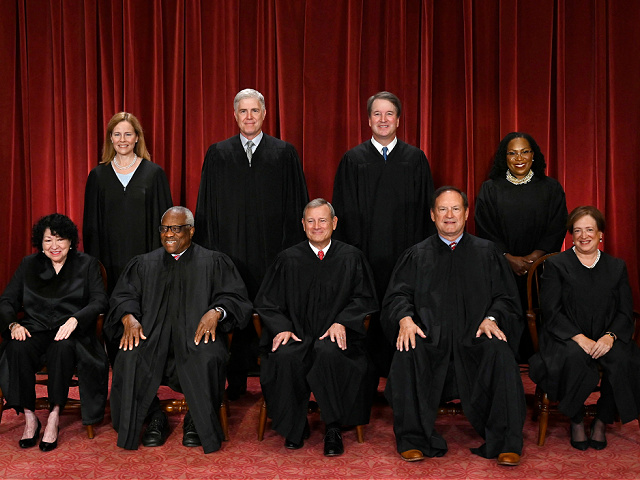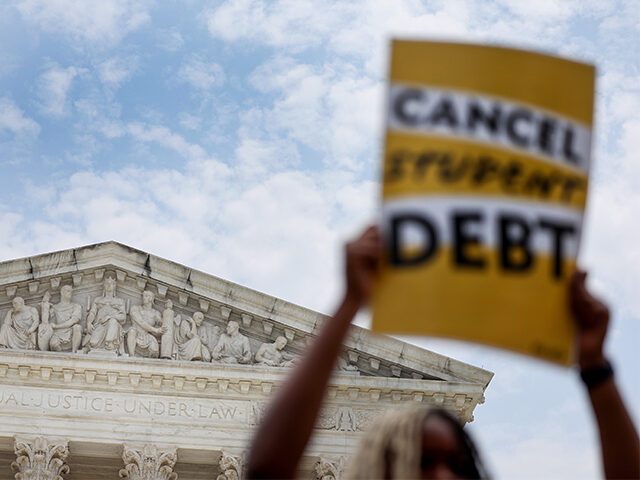The Supreme Court’s Anti-Inflationary Student Loan Decision
The Supreme Court just gave a boost to the Federal Reserve’s efforts to tame inflation.
The high court on Friday struck down President Joe Biden’s scheme to forgive nearly half a trillion of student debt. Combined with the recently announced October end of the pandemic pause on payments, putting these debts back on the balance sheets of the household sector could substantially reduce consumer spending, especially in the services sector where inflation has been stubbornly persistent and threatening to rise.

Justices of the U.S. Supreme Court pose for their official photo on October 7, 2022. Seated from left: Sonia Sotomayor, Clarence Thomas, John Roberts, Samuel Alito, Elena Kagan, Standing from left: Amy Coney Barrett, Neil Gorsuch, Brett Kavanaugh, and Ketanji Brown Jackson. (OLIVIER DOULIERY/Getty Images)
Researchers at the Federal Reserve Bank of New York calculated that roughly $440 billion of federal student loans would have been eligible for forgiveness under the scheme rejected by the Supreme Court. The program would have affected 38 million borrowers, according to the researchers, with nearly 40 percent of borrowers having their monthly payments zeroed out and millions more facing reduced payments.
Suspending Student Loans and Debt Forgiveness Fueled Spending
The suspension of student loan payments has been one of the sources fueling consumer spending despite the sharp rise in interest rates. Consumer spending in the first quarter of the year was 8.4 percent higher than it was a year earlier. In the 12 months through May, consumer spending was up 5.9 percent. As this spending has shifted away from goods to services, inflation has followed suit. Curtailing this spending is likely to also reduce inflationary pressures.
In many ways, student loan payment obligations are akin to Social Security payroll taxes, but the chronology of who funds it and who benefits is reversed. Payroll taxes reduce the ability of workers to spend their incomes, offsetting the additional spending enabled by the payment of Social Security benefits to retirees. The spending power is redistributed from the younger workers to older Americans. Student loan repayments also reduce the ability of workers to spend their incomes, offsetting the additional spending enabled by current lending to students.
The suspension of payments did not include a suspension of new loans. The spending funded by the loans was not offset by the spending avoided by payments. As a result, the suspension created additional inflationary pressures. The forgiveness of loans threatened to make this excess spending a permanent part of the economy. The Supreme Court’s decision restores the balance between lending and repayment, reducing the inflationary pressures.
The forgiveness of student loans was likely to have an even bigger inflationary effect than the dollar amount the price-tag suggests because so many of the beneficiaries of the Biden program were likely to have a high propensity to spend the extra dollars in their bank accounts. That’s because the beneficiaries of the program would have been younger, have smaller incomes, and worse credit scores than the general population.
A paper from researchers at the University of Chicago found that “paused borrowers” were not using the extra money to pay down debts but to fund spending elsewhere:
Paused borrowers do not use their additional liquidity to pay down other debt. Rather, household leverage rises as borrowers make higher payments on other loans, and mortgage, auto, and credit card debt rise. Overall, excluding student loans, household leverage increases by $1,200 (3%) for households subject to the pause. Student loan balances increase by a similar amount. This suggests that the payment pause led to higher durable and non-durable consumption in the short term, but higher overall leverage.
Here’s how the New York Fed researchers explained the impact in terms of different borrowers and regions:
The plan disproportionately benefits younger borrowers and those with below-median credit scores. Borrowers living in below-median income neighborhoods receive a larger share of total forgiveness than their share of outstanding balances. We find that Black borrowers have the largest average forgiveness amount and Hispanic borrowers are the most likely to have their balance entirely forgiven. The South and Midwest benefit the most as regions, and Mississippi, South Carolina, and Georgia are the largest beneficiaries by state.
With the program now deemed illegal, you can read that passage in reverse. The areas and populations that saw the biggest benefits from suspended student loan payments will now likely see the biggest reductions in consumer spending.
Will the Resumption of Payments Spur a Recession?
Just how much of a reduction in spending and inflation this decision will bring remains to be seen.
Some economists have predicted that the combined effect of higher interest rate, fading (but still lingering) stimulus payments, and the resumption of student loan payments could push the economy into a recession. Others, including analysts at Morgan Stanley, have said they see a more modest effect. Morgan Stanley estimated that student loan repayment resumption would shave just six to nine basis points off of GDP.
The likely results, in any case, will not be felt until late this year or early next year. So, this does not change our view that a recession in 2023 remains more unlikely than a recession next year.

COMMENTS
Please let us know if you're having issues with commenting.